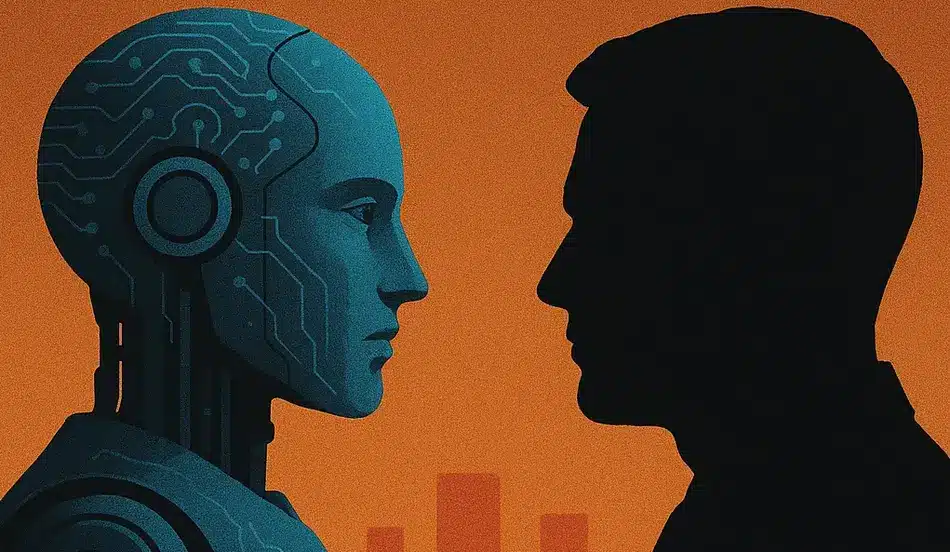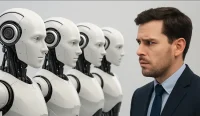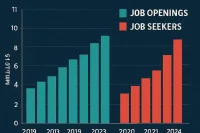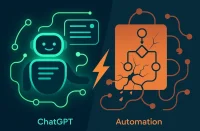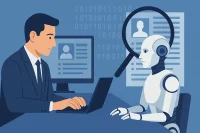AI and the Future of Work is no longer a theory—it’s the operating system of modern careers. Yet many young professionals still look to tutorial makers and job-hacking playlists to navigate the future. It feels safe: curated paths, well-defined steps, a sense of progress. But that security is often a mirage. Real breakthroughs aren’t born from checklists; they come from experiments, from building, from watching how users behave, and from betting on emerging technology before it has formal job titles. The people shaping the future of work aren’t waiting for official playbooks—they are writing them in real time.
Two truths define today’s shift. First, AI is deeply capable at creative work and rapidly improving at reasoning, planning, and multi-step execution. Second, outcomes matter more than inputs. The market is moving away from paying for effort and toward paying for results. That means fewer roles will reward merely the ability to code or memorize interview algorithms. Instead, you’ll thrive by designing systems, managing AI agents, synthesizing user needs, and crafting distribution—the longstanding but underappreciated engine behind success.
This is a wake-up call for anyone still optimizing for interviews in a world that is optimizing for outcomes. The future belongs to those who treat their career like a product: test hypotheses, iterate, and ship. In this article, I’ll show you why the old advice is breaking down, what actually works, and how to build a resilient career strategy in the era of AI and the Future of Work.
Why Tutorials Don’t Map to Breakthrough Careers
The seduction of certainty
Tutorial makers offer structure and clarity. That structure feels like progress—watch a playlist, follow a roadmap, pass an interview. But the future isn’t made by people who follow maps; it’s made by people who explore uncharted terrain. Practitioners who set trends don’t behave like teachers; they probe weird edges, try tools with no job titles yet, and push into domains where vocabulary itself hasn’t stabilized.
Experiments beat narratives
A few years ago, predicting that AI would take creative jobs sounded “inflammatory.” But behind the prediction were actual experiments: early access to image generation models, hands-on plays with APIs, and tools built to pressure-test possibilities—like automated thumbnail generation for YouTube. The insight wasn’t a vibe; it came from wrestling with the technology’s constraints and watching it improve. In the end, the thesis was correct: creative workflows are now heavily automated, and high-quality AI thumbnails (and full video workflows) are routine. For context on earlier shifts in creativity and jobs,
The market punishes laggards
When you stick to outmoded paths, you’re competing in a crowded arena for shrinking rewards. When you run experiments early, you build intuition that compounds. You start predicting—not by guessing—but by building. That edge turns into a career moat.
From Coding to Orchestrating: Reasoning Models Change the Game
System 1 vs. System 2: Why reasoning matters now
Psychologist Daniel Kahneman described two modes of thinking: fast, intuitive “System 1” and slow, deliberate “System 2.” Early AI excelled at mimicry and pattern matching (System 1). What’s new is the rise of models and configurations that simulate System 2: more deliberate reasoning, multi-step planning, and self-correction. That shift is not academic—it fundamentally changes how we build software and run businesses.
Agents are graduating from toy to teammate
Agentic workflows—once janky demos—now complete complex tasks with minimal human scoping. We’ve seen them write real code, do targeted research, and chain tools together. Open-source experiments like Auto‑GPT showcased the concept early: break down goals, plan steps, execute with looped reasoning. The tech wasn’t perfect, but the direction was unmistakable. Today’s reasoning models and improved tool-use frameworks push agents meaningfully closer to production value.
What this means for developers
Coding splits into two parts: (1) thinking through the problem (analysis, design, trade-offs) and (2) typing the implementation. The second part is evaporating quickly, and even parts of the first are being augmented by agents. Your job increasingly becomes orchestration: define constraints, diagnose failures, guide strategies, and verify outcomes. The most effective developers will think like product managers and systems architects who use AI and the Future of Work as a force multiplier.
Outcome-Driven Careers: Distribution Over Deliverables
Features are commodities; distribution is scarce
In a SaaS arms race, features get copied in days. If your differentiator is “we built it from scratch,” you’re vulnerable. Customers care about utility, trust, and time-to-value—not artisanal implementations. When software becomes cheap to build, the scarcest resource becomes attention and adoption. That’s distribution: the ability to consistently reach and move people.
Creators aren’t “just creators” anymore
As the cost of building software approaches zero, more companies will compete for the same customer attention. This makes creators—those with direct distribution—central to product success. The smartest operators are using AI to scale high-quality content, build trust, and test offers rapidly. The setup that wins blends automated generation with human editorial judgment and a fast news-to-video pipeline.
Why outcomes are the only safe bet
Outcome-driven roles resemble commissioned sales: you’re rewarded when value is delivered. Scary? Maybe. Realistic? Absolutely. We’re returning to a pre-industrial pattern where craftspeople, traders, and farmers were judged on results, not process. The future of work won’t pay you to practice; it will pay you to perform.
- Deprioritize: grinding purely for interviews, arguing tools, chasing titles.
- Prioritize: small public experiments, AI-augmented workflows, owning outcomes, building distribution.
Hire for Outcomes, Not Just Deliverables
In a world where features are commodities, distribution and results matter most. Employers can gain a competitive edge by hiring talent that understands outcomes, builds trust, and drives adoption. Post your job on WhatJobs today and connect with professionals who focus on performance, not just process.
Post a Job Free for 30 Days →Run Experiments: Your New Career Operating System
The two habits that compound
Run your own experiments: build proof-of-concepts, launch micro-projects, test distribution channels, and validate with users. Think like a manager: orchestrate AI agents, define metrics, and take responsibility for outcomes. Your leverage comes from diagnosing bottlenecks and aligning tools to goals in AI and the Future of Work.
A practical loop for the next 90 days
Hypothesize a user problem in a niche you understand. Build a simple AI-augmented solution (even a no-code prototype). Ship to a small audience; collect real usage feedback. Iterate weekly with clearer constraints and better prompts. Layer in distribution experiments: short videos, email sequences, partnerships. Double down only where traction appears; drop the rest ruthlessly.
Creative Workflows: What Actually Works Right Now
From “can we do it?” to “how well can we do it?”
The early struggle in creative automation was identity and structure. Face replacement was not enough; likeness required better control over features, texture, and facial structure. Now, with improved fine-tuning methods and LoRA-based approaches, avatar fidelity is high, voice cloning is natural, and end-to-end editing pipelines are efficient. The most effective teams pair AI generation with human editorial polish for speed and quality.
The fastest path to results
Use AI for high-variance ideation and drafts; keep a human-in-the-loop for taste, ethics, and narrative cohesion; standardize review criteria to reduce rework; pre-build templates for thumbnails, formats, and hooks; track metrics that matter: retention, watch time, and conversion—not vanity views. For creator-economy shifts,
Remote Work, Revisited: The Nuance That Matters
The macro prediction was right—until it wasn’t
Remote work surged post-pandemic, validating early predictions. But mass-remote for early-stage, rapidly iterating teams revealed a hidden cost: speed. Innovation cycles slowed without the serendipity and real-time synthesis of co-location. For established companies with stable operations, remote remains powerful. For new ventures seeking product-market fit, hybrid or in-person often wins.
Takeaway for your career
Be flexible, not dogmatic. Align your work mode to the phase of the product and the speed of iteration required. Optimizing for learning velocity beats optimizing for comfort in AI and the Future of Work.
What to Stop Doing—and What to Start
Deprioritize vs. Prioritize
Deprioritize optimizing purely for interviews and DSA drills if your goal is creation or impact; arguing about tools instead of shipping products; chasing titles instead of traction. Prioritize running small, fast experiments in public; building and managing AI‑augmented workflows; owning outcomes: revenue, users, retention; investing in distribution: content, community, partnerships.
The Mindset Shift That Unlocks the Next Five Years
Evidence over opinion
AI and the Future of Work rewards honesty with yourself and with the market. You will be wrong—often. That’s not the problem. The problem is refusing to test. Replace beliefs with experiments, replace defensiveness with data, and replace borrowed paths with original work. You don’t need everyone to agree. You need the right users to stay.
Live Example (User Point of View)
I’m a junior developer who kept grinding interview prep with little success. After reframing my path around AI and the Future of Work, I picked a niche—small gyms needing better lead follow‑up. In one week, I built an agent‑driven WhatsApp follow‑up system using off‑the‑shelf AI APIs, integrated it with a simple CRM, and created three short demo videos explaining the outcomes. I offered a 14‑day pilot to five local gyms. Two said yes. By week three, both reported higher conversion from inquiries to trial sign‑ups. I doubled down, added automated reminder templates, and raised my pilot fee. I didn’t get a job; I built a business with proof.
